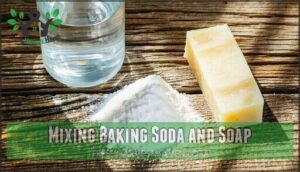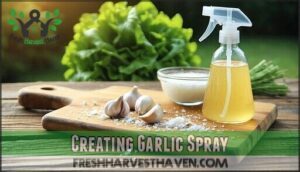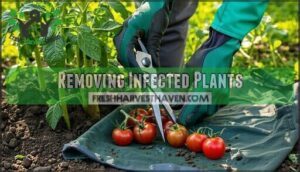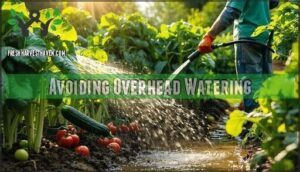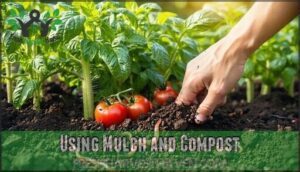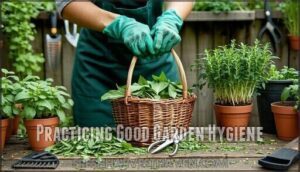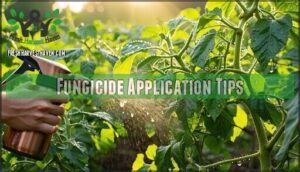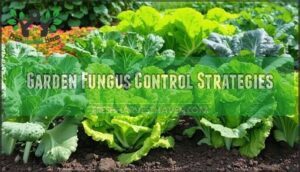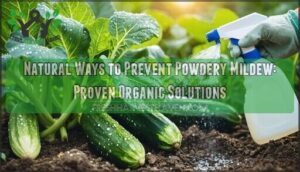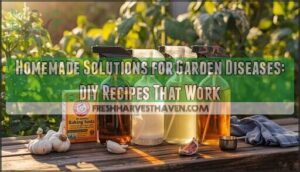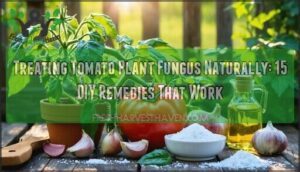This site is supported by our readers. We may earn a commission, at no cost to you, if you purchase through links.
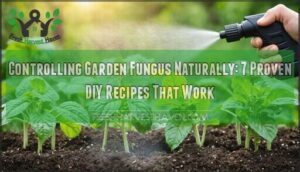
Baking soda mixed with liquid soap creates an effective spray that disrupts fungal cell walls.
Apple cider vinegar changes soil pH, making it hostile to fungus growth.
Neem oil acts as nature’s fungicide while protecting beneficial insects.
For prevention, improve air circulation around plants and avoid overhead watering that creates damp conditions fungi love.
Remove infected plant debris immediately to stop spores from spreading.
These controlling garden fungus naturally methods work best when you combine multiple approaches and apply treatments consistently.
The secret lies in understanding which ingredients target specific fungal types.
By using these methods, you can effectively control garden fungus and create a healthier environment for your plants.
Table Of Contents
- Key Takeaways
- Natural Fungicide Ingredients
- Homemade Fungicide Recipes
- Fungus Prevention Methods
- Fungicide Application Tips
- Garden Fungus Control Strategies
- Frequently Asked Questions (FAQs)
- Can plant fungus be treated naturally?
- How do I prevent fungus in my garden?
- Should you use a natural fungicide if you have a fungal infection?
- How do you get rid of fungal infections in plants?
- How can I prevent and treat fungal infections naturally?
- How do you get rid of fungus naturally?
- Will vinegar kill garden fungus?
- What home remedy kills fungus?
- Can you use natural fungicides in your garden?
- How to prevent fungal diseases in plants?
- Conclusion
Key Takeaways
- You’ll find the most effective natural fungicides in your kitchen – baking soda mixed with liquid soap disrupts fungal cell walls, while apple cider vinegar changes soil pH to create hostile conditions for fungus growth.
- Prevention beats treatment every time by improving air circulation around plants, avoiding overhead watering that creates damp conditions, and removing infected plant debris immediately to stop spores from spreading.
- You can create powerful homemade fungicide sprays using common ingredients like garlic (which releases allicin compounds), neem oil (nature’s dual-purpose fungicide and pest control), and horseradish root steeped in water.
- Consistent application is key to success – apply your natural fungicides every 7-10 days, spray early morning for best results, and combine multiple approaches rather than relying on a single treatment method.
Natural Fungicide Ingredients
You’ll find the most effective natural fungicide ingredients are already sitting in your kitchen and garden shed.
These common household items like baking soda, apple cider vinegar, garlic, and neem oil create powerful antifungal solutions that protect your plants without harmful chemicals.
Baking Soda Fungicide
Your garden’s best defense against fungal diseases starts with baking soda fungicide. This natural fungicide creates an alkaline environment that stops fungi cold, making it perfect for garden fungus control.
Transform your kitchen pantry into a natural plant pharmacy—effective fungicides await!
Mix one teaspoon baking soda per quart of water, adding liquid soap for better coverage. Homemade solutions are often safer and more cost-effective than commercial products.
Baking soda: nature’s pH warrior against plant pathogens!
Baking Soda Benefits include:
- Optimal Concentrations prevent fungal diseases plants without harming foliage
- Application Timing matters—spray early morning for best results
- Effectiveness Boosters like vegetable oil enhance this homemade fungicide
Always test Plant Sensitivity first.
Garlic Fungicide
You’ll tap into garlic’s allicin potency by crushing fresh cloves for your homemade fungicide. This natural remedy outperforms many store-bought options through proper garlic preparation methods.
| Ingredient | Amount |
|---|---|
| Fresh garlic cloves | 5-6 cloves |
| Water | 2 cups |
| Liquid soap | Few drops |
Steep crushed garlic overnight, strain, then dilute before spraying. Application frequency matters—reapply weekly for garlic benefits.
Apple Cider Vinegar Fungicide
Apple cider vinegar creates an effective natural fungicide through its 5% acetic acid content.
This homemade fungicide disrupts pH balance on plant surfaces, making conditions hostile for fungi.
Mix four tablespoons per gallon of water for proper ACV concentration.
It’s particularly effective against black spot diseases on roses.
Test on individual leaves first—leaf sensitivity varies by species.
Apply your vinegar spray every 7-10 days, adjusting application frequency based on fungal specificity and plant response.
Neem Oil Fungicide
Neem oil fungicide packs a one-two punch against garden fungus control and pests. Its azadirachtin compound disrupts fungal growth while targeting insect life cycles—making it your dual-purpose solution for organic gardening.
Mix 1-2 tablespoons neem oil with water plus dish soap for proper emulsification. Apply weekly, but test first since some plants show sensitivity.
Diatomaceous earth helps as an additional barrier. Store in cool, dark places and reapply after rainfall for effective natural pest control.
Horseradish Fungicide
Horseradish packs serious antifungal punch with its natural glucosinolates.
This homemade fungicide targets multiple fungal diseases effectively. Blend fresh horseradish root with water, strain, then spray infected plants.
Horseradish benefits include broad plant compatibility and impressive effectiveness testing results. Apply weekly for maximum garden fungus control.
Recipe variations can include garlic or peppers for enhanced protection.
Cornmeal Fungicide
Cornmeal transforms your garden soil into a natural fungicide powerhouse.
Texas A&M researchers discovered cornmeal benefits include stimulating beneficial microorganisms that suppress harmful fungi like damping-off and root rot.
You can apply this homemade fungicide as a soil amendment at 100-400 grams per square meter, or try brewing cornmeal tea for foliar sprays.
Application frequency should be monthly for best results against specific fungi while promoting overall garden health naturally.
Homemade Fungicide Recipes
You can create effective fungicides using common household ingredients that cost less than store-bought chemicals and won’t harm your plants or family.
These proven recipes combine natural antifungal properties with simple preparation methods, giving you powerful tools to combat garden diseases without toxic side effects, using natural antifungal properties.
Mixing Baking Soda and Soap
Creating your baking soda fungicide requires the right baking soda ratio: dissolve one teaspoon per quart of water completely.
Add half a teaspoon of mild soap solution to improve leaf adherence. This homemade fungicide adjusts pH balance, making surfaces hostile to fungi.
You can also use dish soap and oil to control pests.
Apply your baking soda spray weekly as a natural fungicide, testing sensitivity first. Consistent application frequency guarantees effective control.
Creating Garlic Spray
Garlic fungicide harnesses allicin potency to combat stubborn fungal infections.
Garlic’s natural allicin compounds create a powerful shield against garden fungal invaders!
You’ll need five fresh garlic cloves blended with two cups of water, then strained. This natural fungicide offers excellent garlic benefits for your garden’s health.
- Garlic preparation: Crush cloves thoroughly for maximum allicin release
- Spray preparation: Add liquid soap drops for better leaf adherence
- Application frequency: Apply weekly during active growing season
- Recipe variations: Double concentration for severe infections
Using Apple Cider Vinegar Solution
Apple cider vinegar works as a homemade fungicide by disrupting soil pH balance around plant roots.
Mix four tablespoons per gallon of water, adjusting ACV concentration based on plant sensitivity.
This natural fungicide targets various fungal types through regular application frequency.
| Factor | Recommendation |
|---|---|
| ACV Concentration | 4 tablespoons per gallon |
| Application Frequency | Every 7-10 days |
| Best Timing | Early morning |
| Plant Sensitivity | Test on single leaf first |
Making Neem Oil Solution
In the context of Neem Oil Benefits, this natural fungicide packs a punch against garden pests and diseases.
Mix 1-2 tablespoons of neem oil with a gallon of water, adding a teaspoon of mild soap for proper emulsification. Solution Concentration matters—stick to these Mixing Instructions for safety.
More information on fungicide product options is available online.
Apply weekly as your go-to natural remedy for ecofriendly gardening.
- Golden oil coating leaves like protective armor
- Gentle mist settling on infected plant surfaces
- Healthy plants thriving in pesticide-free gardens
Store mixtures cool and shake before use.
Preparing Horseradish Tea
Brewing horseradish tea creates one of nature’s most potent homemade fungicides.
Grate two tablespoons of fresh horseradish root and steep in one quart of boiling water for 30 minutes.
This DIY remedy harnesses horseradish’s natural antifungal compounds to combat garden fungus effectively.
Strain the mixture and let it cool completely before application.
Store your natural fungicide in the refrigerator for up to one week.
Test on a small leaf first to confirm plant compatibility before widespread use.
Fungus Prevention Methods
You can stop fungal infections before they start by creating the right growing conditions and maintaining good garden practices.
Prevention requires consistent attention to plant spacing, watering methods, and garden cleanliness to keep harmful fungi from taking hold in your garden, which is crucial for prevention.
Removing Infected Plants
Quick early detection saves your entire garden from disaster.
Removing infected leaves immediately prevents plant diseases from spreading like wildfire. You’ll need to sanitize tools between cuts and practice safe disposal methods.
- Proper Disposal: Bag infected material—never add to compost piles
- Preventing Spread: Wash hands thoroughly before touching healthy plants
- Tool Sanitation: Clean pruners with rubbing alcohol after each cut
Improving Air Circulation
Proper plant spacing prevents moisture buildup that fungi love.
Give your plants room to breathe by spacing them according to their mature size.
Use pruning techniques to thin dense foliage and remove overlapping branches.
Trellising methods elevate climbing plants for better airflow management.
Strategic fan use in greenhouses improves circulation, while windbreaks protect without blocking essential air movement.
Wide spacing helps to reduce humidity and improves overall air circulation.
Avoiding Overhead Watering
Better air circulation sets the stage for smart watering techniques that prevent foliage wetness.
Proper watering at soil level keeps leaves dry and stops fungal spores from taking hold.
Root hydration through efficient irrigation beats overhead sprinklers every time.
Consider these water conservation strategies:
- Use drip systems for targeted disease prevention
- Install soaker hoses near plant bases
- Water early morning to reduce moisture buildup
Using Mulch and Compost
Smart gardeners know that mulch and compost create a living fortress around your plants.
Organic matter feeds beneficial microbes that outcompete harmful fungi, while mulch types like straw regulate moisture and temperature.
Compost benefits include improved soil health through enhanced decomposition rates. Many gardeners find garden mulch options helpful for this purpose.
- Apply 2-3 inches of mulch around plants, keeping it away from stems to prevent moisture buildup that encourages fungal growth.
Practicing Good Garden Hygiene
Clean gardens resist fungal attacks better than messy ones.
Debris removal clears fallen leaves that harbor spores.
Tool sanitation prevents spreading infections between plants.
Weed control eliminates hiding spots for pests and diseases.
| Garden Hygiene Task | Frequency | Fungal Prevention Benefit |
|---|---|---|
| Debris removal | Weekly | Eliminates spore breeding grounds |
| Tool sanitation | After each use | Stops cross-contamination |
| Weeding | Bi-weekly | Reduces pest shelter |
| Soil solarization | Seasonally | Kills soil-borne pathogens |
| Composting practices | Ongoing | Creates healthy soil microbiome |
Garden sanitation creates an environment where beneficial organisms thrive while harmful fungi struggle to establish themselves.
Fungicide Application Tips
Creating effective homemade fungicides is only half the battle; proper application techniques determine your success in controlling garden fungi.
You’ll need to follow specific timing, coverage, and frequency guidelines to guarantee your natural treatments work effectively against fungal infections, ensuring that your natural treatments are applied correctly to achieve the desired outcome.
Spraying Infected Areas
When fungal spots appear, target infected areas with precision. Your natural fungicide needs complete leaf coverage – don’t forget undersides where spores love to hide.
Spray timing matters: early morning works best before sun intensifies. Check solution strength against plant sensitivity – some varieties can’t handle strong concentrations.
Weather impact affects results, so avoid windy days that scatter your homemade fungicide. Use proper spraying techniques with steady, overlapping passes.
DIY fungicidal spray and fungicidal sprays work when you’re thorough and methodical. You can find products for a DIY spray solution online.
Applying Fungicide Regularly
Regular fungicide application creates a protective shield that keeps fungal diseases at bay.
Apply your homemade fungicide every 7-10 days, adjusting application frequency based on weather impact and plant sensitivity.
- Monitor solution strength to avoid plant damage while ensuring effectiveness
- Use proper coverage techniques by spraying both leaf surfaces thoroughly
- Adjust timing based on humidity levels and recent rainfall patterns
Using Preventative Sprays
Prevention beats treatment every time with preventative sprays. Apply your natural fungicide before disease strikes for maximum protection. Early application works best during cool morning hours when weather conditions are calm.
Disease prevention strategies include:
- Test solution strength on sensitive plants first
- Make certain complete leaf coverage including undersides
- Monitor plant sensitivity and adjust homemade fungicide concentration accordingly
Natural remedies protect plants when applied consistently.
Avoiding Eye Contact
Safety comes first when applying your natural fungicide. Always wear protective eyewear to shield your eyes from splashes.
Check wind direction before spraying—you don’t want homemade remedies blowing back at you. Use spray nozzles with controlled streams for better application precision.
Keep first aid basics nearby, just in case. Your natural solutions work best when you’re protected and prepared.
Reapplying After Rainfall
Rain washes away your natural fungicide protection, leaving plants vulnerable to fungal infections.
Weather monitoring helps you time reapplications perfectly. After storms, inspect treated areas and reapply homemade fungicide within 24 hours for maximum fungicide adherence.
Consider these essential factors for effective reapplication:
- Concentration adjustment – strengthen diluted solutions from heavy rainfall
- Frequency increase – apply every 3-5 days during wet weather periods
- Runoff prevention – focus on leaf undersides where homemade remedies stick better
Garden Fungus Control Strategies
You can’t fight garden fungus effectively without a solid prevention strategy that starts with selecting disease-resistant plants and maintaining healthy soil conditions.
Smart gardeners know that proper crop rotation and soil management create an environment where beneficial microorganisms outcompete harmful fungi, reducing your need for treatments later, which is a key part of a prevention strategy.
Choosing Healthy Plants
Your garden’s success starts at reputable nurseries where you’ll find disease-resistant plants with proven plant resilience.
Create an inspection checklist: examine root health for white, firm roots and check foliage for spots or yellowing.
Smart variety selection means choosing cultivars bred for disease resistance and plant wellness.
Strong healthy plants with natural plant sensitivity to threats become your garden’s foundation against fungal problems.
Maintaining soil health, including proper pH management, is also essential for preventing diseases.
Crop Rotation and Soil
Rotating crops strategically breaks the cycle of soilborne pathogens that thrive when you plant the same families repeatedly.
This practice prevents nutrient depletion while improving soil structure and composition.
Healthy soil becomes your garden’s immune system against fungal diseases.
Here are key rotation benefits you’ll gain:
- Disrupts fungal life cycles by removing host plants
- Enhances soil nutrients through diverse root systems
- Improves soil health with varied organic matter
- Reduces disease pressure naturally over time
- Supports beneficial microorganisms that fight pathogens
The key to successful crop rotation is understanding how it supports beneficial microorganisms.
Frequently Asked Questions (FAQs)
Can plant fungus be treated naturally?
Yes, you can treat plant fungus naturally using household ingredients like baking soda, garlic, apple cider vinegar, and neem oil.
These homemade fungicides effectively combat infections while being safer for your plants and environment, making them a great alternative to chemical treatments, and they are also naturally better.
How do I prevent fungus in my garden?
Like building a fortress against invaders, you’ll prevent garden fungus by improving air circulation, avoiding overhead watering, choosing healthy plants.
Ensuring proper drainage, and maintaining good garden hygiene through regular debris removal are also crucial steps in preventing garden fungus.
Should you use a natural fungicide if you have a fungal infection?
Natural fungicides work effectively when you catch fungal infections early. You’ll get better results applying homemade treatments like baking soda or garlic spray immediately after spotting symptoms rather than waiting.
How do you get rid of fungal infections in plants?
Remove infected plant parts immediately, improve air circulation by spacing plants properly.
Apply homemade fungicides like baking soda spray, avoid overhead watering.
Make certain good drainage to prevent future infections, and ensure these practices are followed to avoid future infections.
How can I prevent and treat fungal infections naturally?
Keep your garden’s unwelcome guests at bay by improving airflow, watering at soil level, and applying homemade baking soda or garlic sprays.
You’ll create conditions where beneficial microbes thrive while harmful fungi struggle to establish themselves.
How do you get rid of fungus naturally?
You can eliminate fungus naturally using baking soda spray, garlic solutions, or apple cider vinegar mixtures.
Apply neem oil, improve air circulation, remove infected plants, and make certain proper drainage to prevent future outbreaks effectively.
Will vinegar kill garden fungus?
Sarah’s roses showed white powdery spots last spring.
Yes, vinegar kills garden fungus effectively.
You’ll need 4 tablespoons apple cider vinegar per gallon water.
Apply early morning, spray leaf tops and bottoms thoroughly.
What home remedy kills fungus?
You can fight fungus with simple household ingredients.
Mix baking soda with water, blend garlic with oil, or spray diluted apple cider vinegar.
These natural remedies create hostile environments for fungi without harsh chemicals, using methods like diluted apple cider vinegar.
Can you use natural fungicides in your garden?
You can, you should, and you’ll succeed using natural fungicides in your garden.
Baking soda, garlic, apple cider vinegar, and neem oil effectively combat plant diseases while protecting beneficial insects and soil health naturally.
How to prevent fungal diseases in plants?
You’ll prevent fungal diseases by ensuring proper drainage, spacing plants for good airflow, watering at soil level, choosing disease-resistant varieties, and removing infected debris promptly to keep your garden healthy.
Conclusion
Successfully safeguarding your garden from fungal foes becomes achievable when you apply these proven natural methods consistently.
You’ve learned that controlling garden fungus naturally requires combining multiple approaches – from baking soda sprays to neem oil treatments.
Remember, prevention works better than cure, so maintain proper air circulation, avoid overhead watering, and remove infected debris promptly.
With patience and persistence, these DIY fungicides will help you create a healthier, more resilient garden ecosystem without harsh chemicals.
- https://aigardenplanner.com/blog/post/how-to-get-rid-of-garden-fungus-prevention-and-treatment-methods-359
- https://www.thespruce.com/baking-soda-spray-on-houseplants-1902672
- https://www.extension.purdue.edu/extmedia/bp/bp-69-w.pdf
- https://edis.ifas.ufl.edu/publication/IN197
- https://extension.uga.edu/publications/detail.html?number=C862&title=disease-management-in-the-home-vegetable-garden

